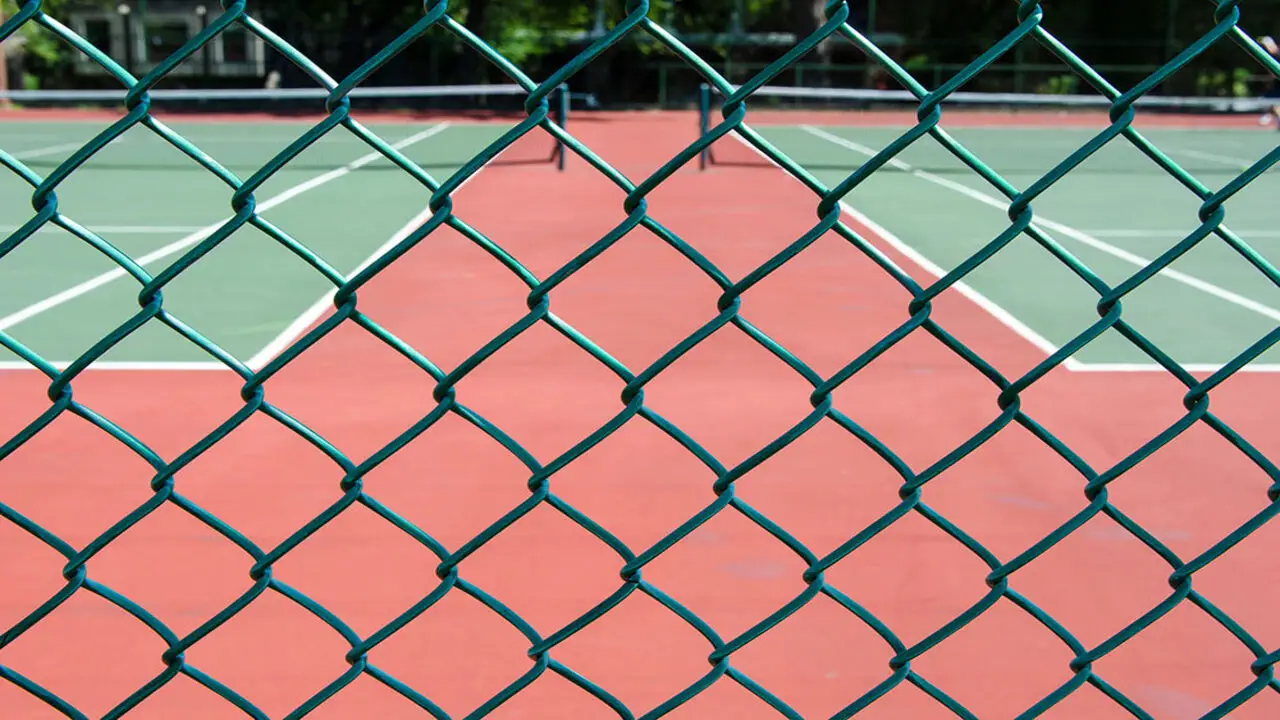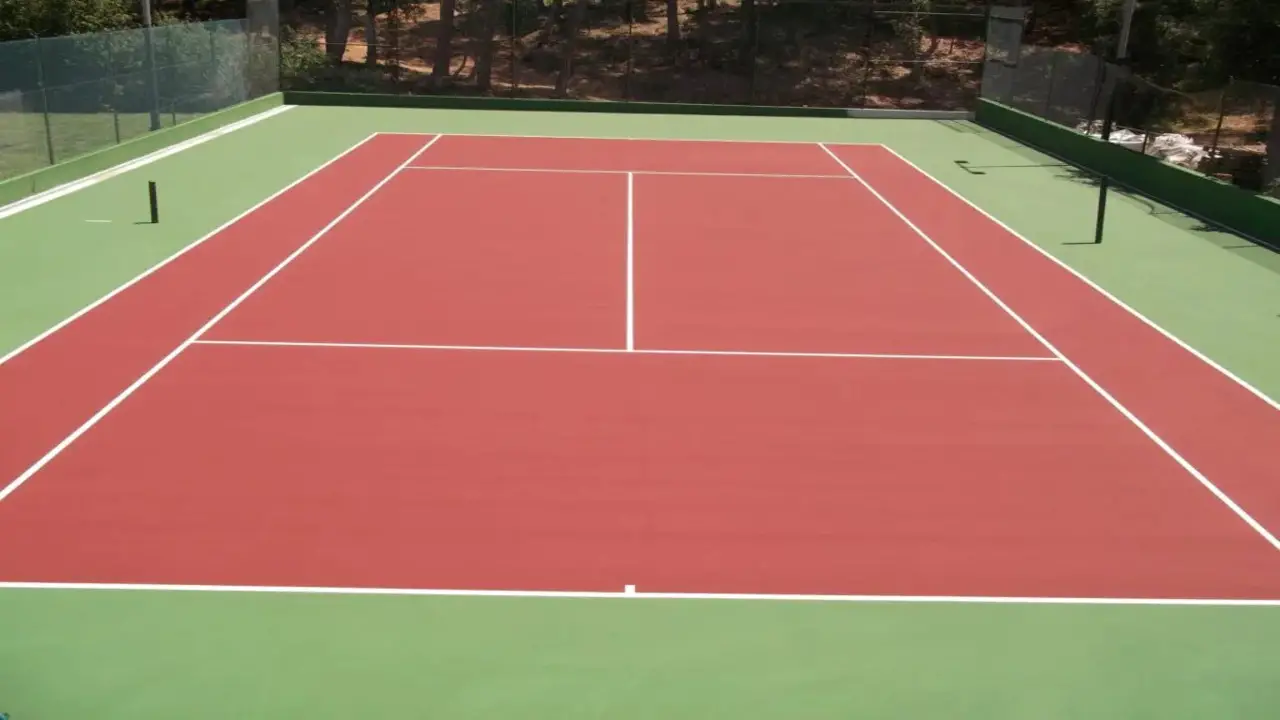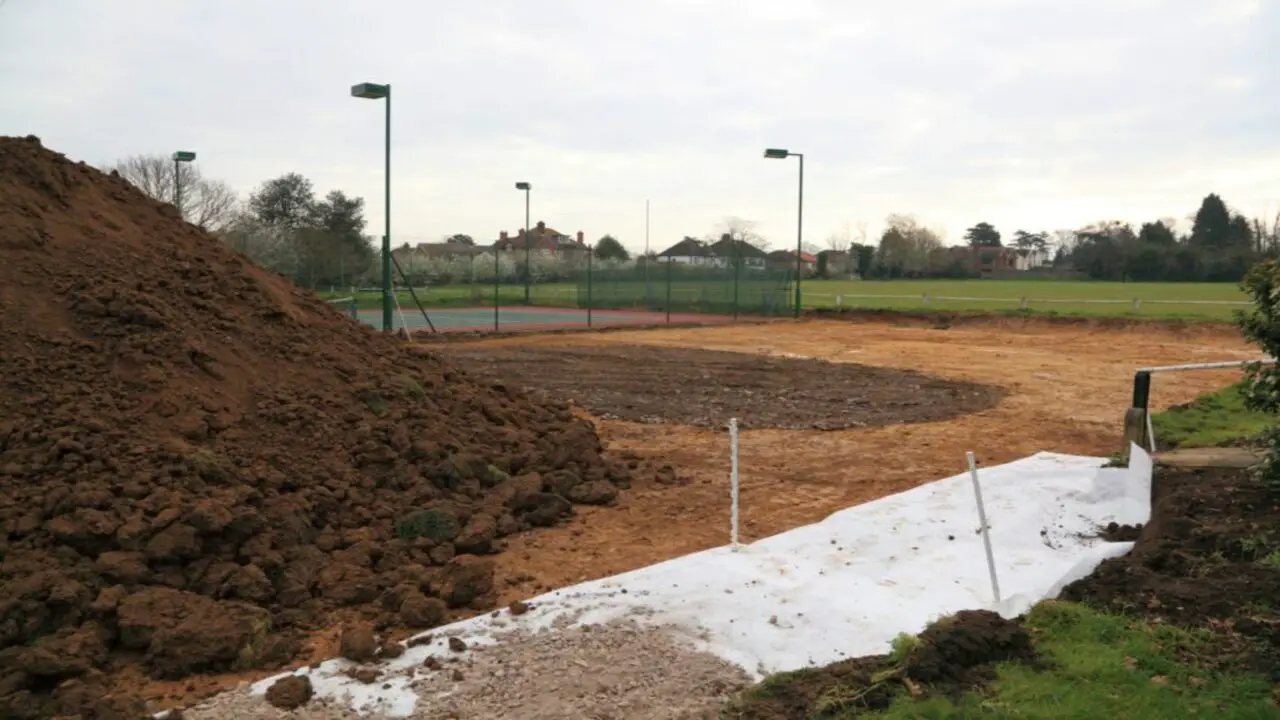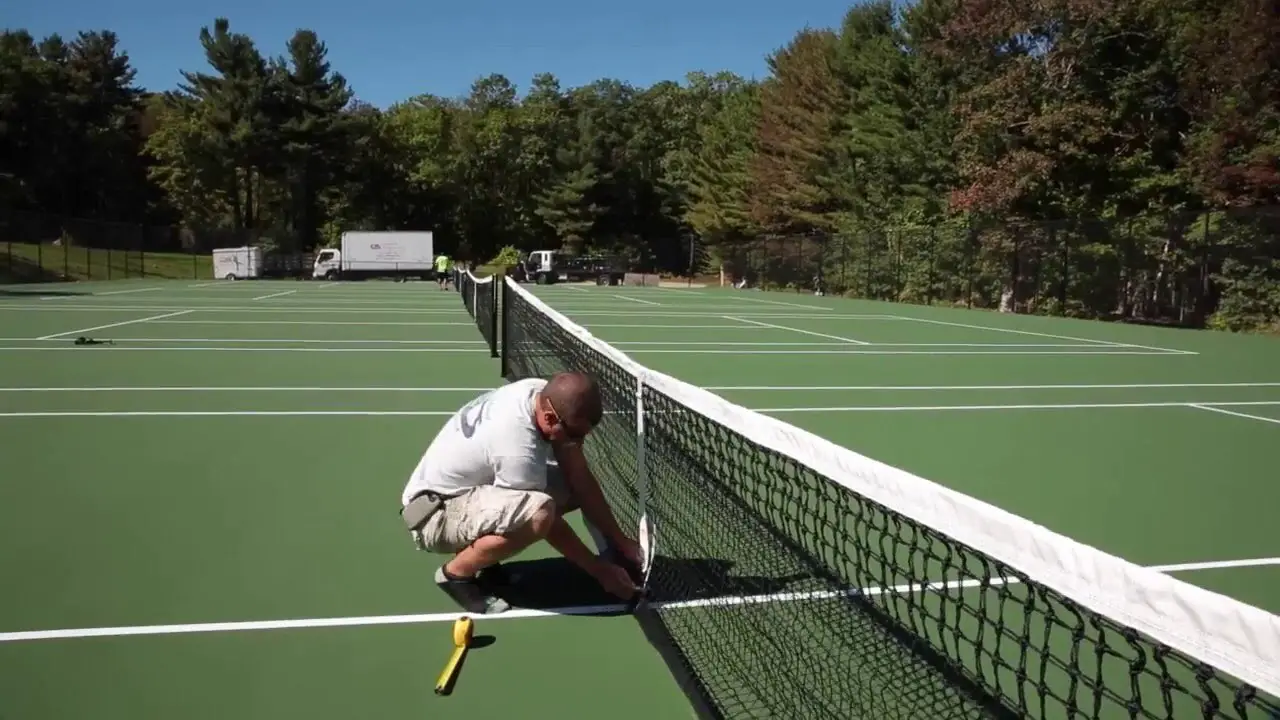Building a tennis court may seem like a daunting task, but with proper planning and execution, it can be a rewarding project for any homeowner or community.
Whether you’re looking to enhance your property’s value or provide a recreational space for your family and friends, constructing a tennis court requires careful consideration of location, materials, and budget. From selecting the right surface to ensuring proper drainage, there are many important steps to ensure that your tennis court meets your needs and stands the test of time.
Here, we’ll explore how to build a tennis court, including site preparation, choosing the right surface, installing fencing and lighting, and ongoing maintenance. We’ll cover important considerations such as local zoning regulations, safety requirements, and tips for selecting the best contractor to help you bring your vision to life.

What Is A Tennis Court?
A tennis court is a designated playing area for the sport of tennis. It is typically rectangular, 78 feet in length and 36 feet in width for singles play, and 78 feet in length and 42 feet in width for doubles play. The court is divided in half by a net, which separates the two sides of the court.
The court’s surface can vary, most commonly being hard, clay, and grass. Tennis courts have specific designs with specific markings for serving, baseline, singles and doubles sidelines, and centre service lines. These markings determine whether a ball is in or out of play. Tennis courts provide a controlled environment for players to compete in a fair and challenging manner.
How To Build A Tennis Court – 5 [Easy Steps]
![How To Build A Tennis Court 2 How To Build A Tennis Court - 5 [Easy Steps]](https://briskhand.com/wp-content/uploads/2024/01/How-To-Build-A-Tennis-Court-5-Easy-Steps.webp)
How to build a tennis court? Building a tennis court requires careful planning and execution. The first step is choosing a suitable location and ensuring the site is level and accessible. After clearing the area, the next step is to lay the foundation using a crushed stone or concrete base. The court should be measured and marked out accurately, and then the net and posts can be installed.
Finally, the surface can be applied, which may involve laying various materials such as clay, grass, or hard court surfaces. The entire process should be overseen by a skilled contractor with experience in tennis court construction, ensuring that the finished product is of high quality and meets all safety standards. Here are 5 easy steps to build a tennis court:
1. Choose The Location
In choosing the location for building a tennis court, there are some important factors to consider, such as the land size, availability of sunlight, accessibility, and soil condition. The ideal location for a tennis court is a flat surface with well-drained soil and good sunlight exposure.
The dimensions of a standard tennis court are 78 feet long and 27 feet wide, with a net height of 3 feet at the centre. Additionally, it is recommended to avoid locations near the road to minimize noise and distraction and to ensure proper fencing to protect against stray balls. It is also important to check local zoning ordinances and regulations to ensure compliance with any applicable rules or permits. Consulting with a professional tennis court builder may also help identify the best location for a tennis court.
2. Prepare The Site
Preparing the site for building a tennis court involves several steps. First, the area must be cleared of obstacles such as trees, rocks, or debris. Next, the ground must be levelled to ensure a smooth playing surface. This may involve adding or removing soil. Once the site is level, a layer of crushed stone or gravel is typically laid down as a foundation. Finally, a layer of asphalt or other hard surface material is added and painted with the appropriate court markings. The process may vary slightly depending on the specific requirements of the court and the location, but these are the basic steps involved in preparing the site for a tennis court.
3. Install The Fence

Constructing a tennis court requires a comprehensive understanding of the necessary components involved in the process. One of the crucial elements of building a tennis court is installing a fence to surround the court. The fence serves as a boundary marker to keep the ball within the designated playing area and prevent it from going out of bounds. Additionally, the fence ensures the safety of the players and spectators by preventing stray balls from entering nearby roads, properties, or other facilities.
Several factors must be considered when selecting a tennis court fence. The height of the fence should be adequate to prevent the ball from easily going over the top. The type of fence material should be durable and able to withstand the ball’s impact, as well as weather conditions such as wind, rain, and sun exposure.
4. Lay The Surface
Building a tennis court is a complex process that requires careful planning and execution. The first step is to choose a suitable surface material that meets your needs and budget. The most common options are asphalt and concrete, durable and relatively low maintenance. Asphalt is popular because it provides good traction and is less expensive than concrete. However, concrete is a more long-lasting option and provides better consistency in ball bounce. Ultimately, the choice of surface material will depend on your goals and preferences.
After selecting the surface material, the next step is to hire a contractor to install it. This critical step requires a skilled professional with experience in tennis court construction. The contractor will prepare the site by excavating the area, grading the surface, and installing a sub-base layer to ensure proper drainage
5. Paint The Lines
Building a tennis court involves several steps: site preparation, surface installation, and line marking. Once the site is selected, it is important to ensure that it meets the requirements for a tennis court. This involves checking the size of the area, drainage, and slope. The surface material handy for the tennis court should also be selected based on factors such as budget, climate, and the intended use of the court. The most common types of tennis court surfaces are concrete, asphalt, and clay. Each surface has its benefits and drawbacks, and the choice of the surface material depends on the players’ preferences.
Once you select the surface material, you can begin the surface installation process. The process involves preparing the area by removing existing vegetation, grading the area, and potentially installing a drainage system. They lay out and level the surface material and apply a binder to ensure it adheres properly. Finally, we apply a topcoat of the chosen material to finish the surface.
Site Selection And Preparation

Site selection and preparation are critical aspects of building a tennis court. The first step in site selection is to evaluate the area’s soil and drainage conditions and the presence of any natural or artificial obstructions that could interfere with the court’s construction. Soil testing is necessary to assess the soil’s suitability for construction, as the court’s foundation and subsoil drainage system must withstand the weight and stress of players running and jumping on the surface. Here are some factors to consider:
- Size And Orientation: A standard tennis court is 78 feet long and 36 feet wide. The orientation should be north-south to avoid the sun interfering with the players’ vision.
- Surface: Tennis courts can be made of various surfaces, such as clay, asphalt, or synthetic materials. Each surface has advantages and disadvantages, so choose the one that suits your needs best.
- Drainage: Proper drainage is essential to prevent water from collecting on the court. The slope of the court should be at least 1% to ensure proper drainage.
- Base: The base under the court should be firm, stable, and well-drained. It should be at least 6 inches thick and made of crushed stone or gravel.
- Fencing And Lighting: Fencing around the court is necessary to keep balls from bouncing out and to provide security.
Choosing The Right Location
Building a tennis court and selecting the right location is a crucial aspect of the process. The first consideration that one must consider is the availability of space. Ideally, a tennis court should have a rectangular shape with a length of 78 feet and a width of 36 feet. In addition to these dimensions, an area of at least 120 feet in length and 60 feet in width should also be available to ensure adequate space for players to move around the court. Therefore, choosing a location that accommodates these minimum requirements is vital. Here are some factors to consider:
- Size: A standard tennis court is 78 feet by 36 feet, so ensure you have enough space to accommodate it.
- Orientation: The court should be north-south to minimize the sun’s glare and wind interference.
- Surface: Choose a location with a flat, level surface that can be easily graded and drained.
- Vegetation: Avoid building a tennis court near trees or other vegetation that could cause problems with roots and debris.
- Access: Make sure the location is easily accessible for players and equipment.
- Zoning: Check with local zoning authorities to ensure the location is suitable for a tennis court and that you have all the necessary permits.
Considering these factors, you can choose a location to provide the best playing experience for you and your guests.
Site Preparation And Clearance
Site preparation and clearance are critical steps when building a tennis court. Before construction begins, workers must clear the site of trees, large rocks, or debris. We must excavate and level the area to ensure it is perfectly flat. We may also need to install drainage systems to prevent water from collecting on the court.
They clear and prepare the site, lay down a base layer of stone dust or crushed stone, and follow it with a layer of asphalt or concrete. Someone paints the court’s surface with the appropriate markings and lines for tennis play. Proper site preparation and clearance are crucial in ensuring the tennis court is safe and functional for players.
Soil Testing And Analysis

Soil testing and analysis is an important step in building a tennis court. This involves taking soil samples from the site and analyzing them for factors such as texture, composition, and pH level. The results of the analysis can provide important information on the suitability of the soil for building the tennis court, as well as any necessary adjustments that need to be made to ensure proper drainage and stability.
A professional soil testing and analysis company can guide the appropriate testing methods and offer recommendations on soil amendments or other necessary actions to ensure the best playing surface for the tennis court.
Drainage Considerations
When building a tennis court, drainage considerations are crucial. Poor drainage can accumulate water, damaging the court surface and causing safety hazards. Construct the court with a slope of at least 1% to allow proper water runoff.
Additionally, installing a drainage system with perforated pipes and drainage tiles can help prevent water accumulation and prolong the life of the court surface. It’s also important to consider the surrounding landscape and ensure water from nearby areas does not flow onto the court. Proper drainage will protect your tennis court investment and maintain optimal playing conditions.
Design And Layout
Design and layout are important considerations when building a tennis court. The first step is to determine the size and orientation of the court based on available space and sunlight. The standard size for a tennis court is 78 feet long and 36 feet wide, but other sizes may be appropriate depending on the needs of the players.
Orientation of the court should prevent the sun from interfering with play and surround it with a fence or barrier to prevent balls from leaving the court. The court’s surface should be level and free of any obstructions or hazards that could cause injury. Other design considerations may include the type of surface to be handy (e.g., clay, hard court, or grass) and the seating location, lighting, and other amenities.
Construction
Building a tennis court involves several steps, including site preparation, excavation, levelling, installation of a drainage system, laying a base layer of gravel or crushed stone, installation of the tennis court surface (such as asphalt or concrete), and the markings for the court.
Ensuring the court can regulate size and standards for safe play is important. Hiring a professional contractor with experience in tennis court construction is recommended to ensure a quality result. The cost of building a tennis court can vary depending on factors such as location, materials used, and level of customization.
Maintenance
To build a tennis court, it is also important to consider maintenance. Regular maintenance of a tennis court is essential to ensure its longevity and ensure it remains safe for players to use. Maintenance tasks for a tennis court can include cleaning the surface regularly, repairing cracks or other damage, and applying sealant or resurfacing the court when necessary. It is recommended to consult with a professional tennis court builder or maintenance specialist to determine the specific maintenance needs for your tennis court.
Can You Make A Tennis Court Out Of Concrete?

Yes, it is possible to make a tennis court out of concrete. Concrete is a popular choice for constructing tennis courts as it is durable, low maintenance, and provides a consistent playing surface. However, when building a concrete tennis court, you need to consider certain factors, such as the thickness and quality of the concrete, the slope of the court, and the installation of proper drainage systems.
is important to consult with a professional contractor with experience in constructing tennis courts to ensure that the court is aching to meet regulation standards and provide a safe and enjoyable playing experience.
What Is The Construction Of A Tennis Hard Court?
Constructing a tennis hard court involves a multi-step process that requires precision and attention to detail. The first step involves excavating the surface to a specific depth, followed by installing a drainage system to ensure proper water runoff. First, prepare the base and then apply a layer of porous concrete. Finally, cover it with an acrylic coating to provide a smooth and durable playing surface.
Finally, the installation team lines the court with boundary markings and installs net posts. They must construct the court to the highest standards to ensure player safety and optimal performance.
Conclusion
Building a tennis court requires careful planning, precise measurements and hard work. It is not a task for the faint-hearted, but it can be a rewarding and fulfilling project with the right approach. One can ensure a successful outcome by following the steps outlined in this article, including site selection, surface preparation, fencing, and lighting installation. A properly constructed tennis court will provide years of enjoyment and fitness opportunities for players of all levels.
It is essential to remember that building a tennis court is not a one-time investment. It requires ongoing maintenance and upkeep to ensure its longevity and optimal performance. But with the proper dedication, commitment, and patience, anyone can build a tennis court that meets their needs and exceeds their expectations. We hope now you understand how to build a tennis court.
FAQs
What Are The Necessary Steps To Prepare The Site For Building A Tennis Court?
The necessary steps to prepare the site for building a tennis court are as follows:
- Site evaluation: Evaluate the site to determine if it suits a tennis court. This includes assessing the slope, soil conditions, drainage, and available space.
- Design and layout: Once the site is deemed suitable, design and layout the court to meet the most dimensions and specifications.
What Materials Are Required To Construct A Tennis Court?
To construct a tennis court, the following materials are typically must:
- Excavation equipment
- Gravel and sand
- Concrete or asphalt (for the base layer)
- Paint or turf (for the playing surface)
- Fencing
- Net and posts
- Lighting (optional)
What Are The Most Important Factors To Consider When Choosing The Location?
The materials required to construct a tennis court include:
- Level ground surface
- Fence or enclosure
- High-quality synthetic or natural turf
- Asphalt or concrete base layer
- Gravel or stone base layer
- Paint or colour coating for court lines and markings
- Net and posts
- Lighting (optional)
How Do You Ensure That The Surface Of The Tennis Court Is Safe?
To ensure that the tennis court’s surface is safe, it is important to regularly inspect the court for any cracks, uneven patches, or other hazards that could cause injury to players. The court should be cleaned regularly to remove debris, and wet or slippery areas should be dried or treated to prevent slipping.
What Maintenance Is Required To Keep A Tennis Court In Good Condition?
To keep a tennis court in good condition, regular maintenance is a must, which includes:
- Cleaning the court surface to remove debris, leaves, and other materials that may accumulate on it
- Resurfacing the court every few years to repair cracks and other damage to the surface
- Checking the net for damage and replacing it if necessary

I am passionate about tools and electric work. I love finding new tools and experimenting with them.

